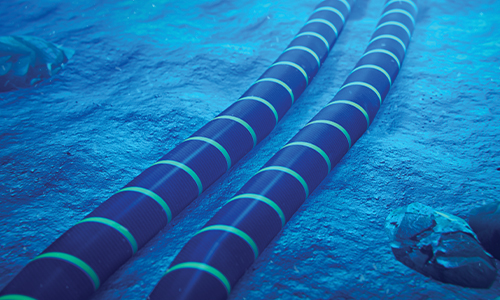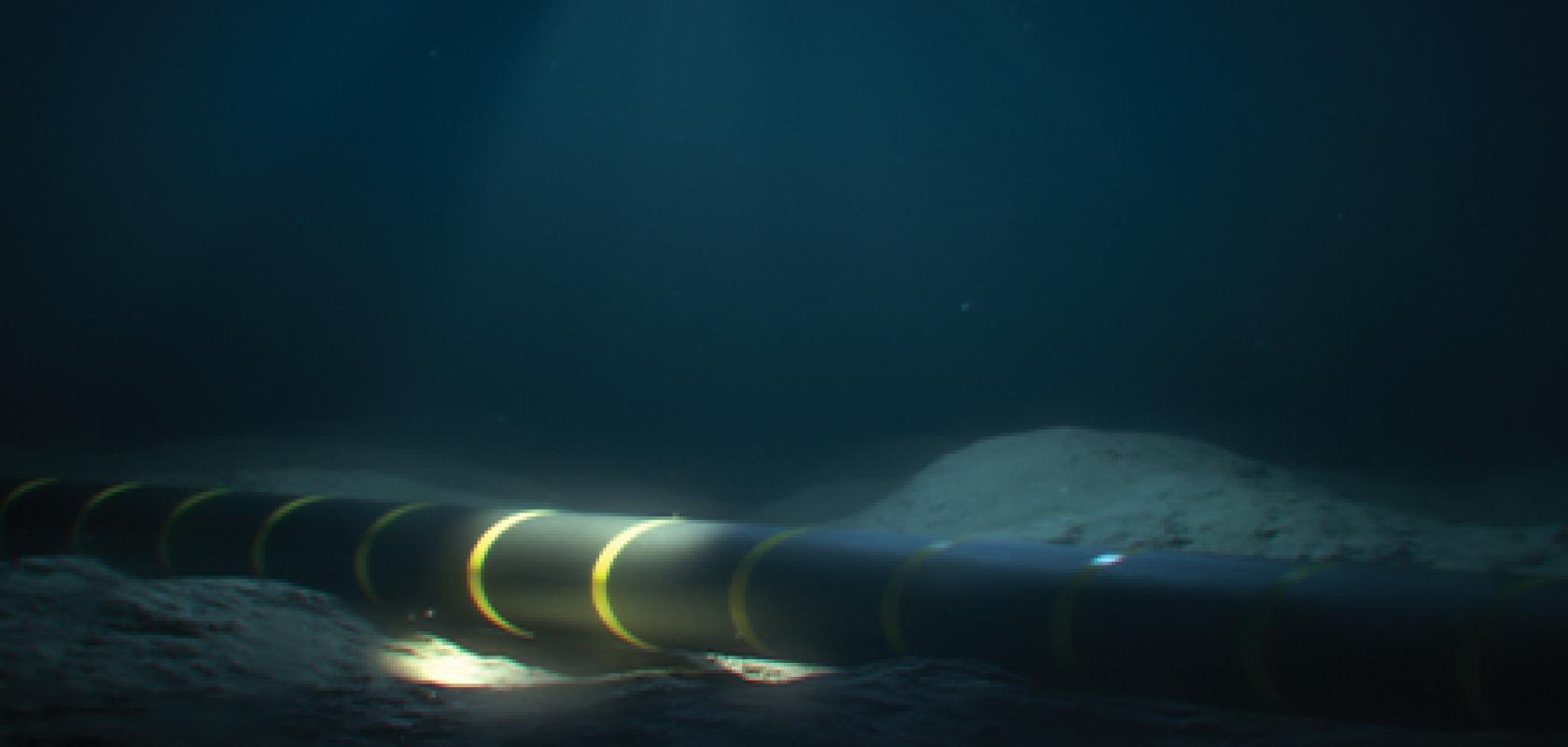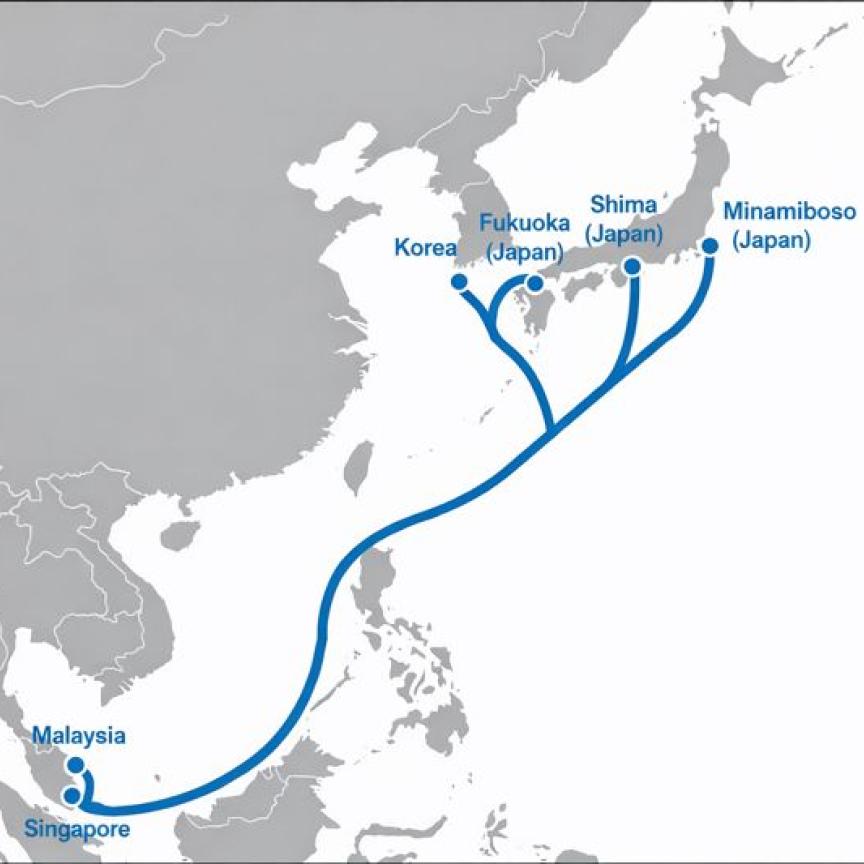Fibre optic sensing uses the light travelling through a fibre to detect changes in temperature, strain and other parameters. The fibre itself becomes the sensor here, creating many continuous points along the fibre.
Traditionally in optical communications, optical network sensing has been used by engineers to inspect and monitor the network, looking for any excessive strain or pain points. Fibre can also be used as a probing device to conduct infrastructure monitoring for things like ground movement, damage or leakage along a pipeline, or damage to a cable.
More recently, there have been a number of studies from academic researchers into using fibre networks themselves as sensors, to help understand more about the environment and potentially predict events such as earthquakes and tsunamis. As an example, a team of scientists at the National Physical Laboratory (NPL) recently successfully demonstrated a technique that could transform undersea power and telecom cables into arrays of environmental sensors. This, said the team, could potentially revolutionise monitoring of the earth, allowing scientists to acquire for the first time continuous, real-time environmental data from the bottom of seas and oceans. The results were published in Science.
Giuseppe Marra, principal research scientist at NPL, explained: ‘This new technique opens a new era for Earth monitoring by providing, for the first time, a feasible solution to the lack of environmental data from the bottom of seas and oceans. We can now harness existing underwater cables as a valuable tool for Earth sciences and beyond. This breakthrough is a perfect example of how ultra-stable optical frequency metrology can transition from the laboratory to improve our understanding of the world and also deliver tangible benefits to society.’
Safety in numbers
The demonstration built on previous work by NPL and its partners in 2018, which showed that submarine cables could be repurposed as sensors for the detection of underwater earthquakes by using ultra-stable interferometric techniques. However, in this case, one cable could act only as a single sensor, and measurements were limited only to the integrated changes over the entire length of the cable. The new research has now demonstrated how some cables can be converted into an array of sensors, rather than just a single sensor.
Davide Calonico, researcher at INRiM, said: ‘Our seminal work in 2018 turned coherent laser interferometry from a laboratory technique to a powerful tool for geophysical sensing, and today a new step forward confirms it can be extended to thousands of kilometres, reaching even the most remote areas of our planet. This collaboration also succeeded in demonstrating how optical communication networks can be employed in a smart way, for advancing science and society.’
The NPL-led team, including researchers from the University of Edinburgh, the British Geological Survey, the Istituto Nazionale di Ricerca Metrologica (INRiM) and Google, tested the technique on a 5,860km intercontinental submarine optical fibre link between the UK and Canada. They demonstrated the detection of earthquakes and ocean signals, such as waves and currents, on individual spans between repeaters spread across the entire transatlantic connection. The optical fibre in each span acted as a sensor. Up to 12 sensors were implemented along the cable. Future upgrades will increase this number to 129.
Crucially, the data from these sensors can be recorded, continuously and in real time. The cable-based array of sensors can identify the epicentral area of earthquakes in the same way as land-based seismometers.
It is thought that by applying this new method to an existing network of submarine cables, huge and currently unmonitored areas of the ocean could potentially be equipped with thousands of permanent real-time environmental sensors. It could effectively transform underwater telecoms infrastructure into a giant array of geophysical sensors. Integrating this approach with current seismometer-based networks could provide the potential to substantially expand the global earthquake monitoring infrastructure from land to the seafloor, where only a handful of permanent seismometers are currently installed. It would not require any change to the underwater infrastructure, providing an affordable and scalable solution for sea floor monitoring on a global scale.

Image credit: Vismar UK/Shutterstock.com
World of opportunity
The research also opens up the possibility of monitoring for other natural phenomena – for example, improving our understanding of deep-water flows, including the proposed slowing down of the Gulf Stream due to rising global temperatures. The results demonstrated that the method could also potentially be used for real-time detection of tsunamis. The team now plan to test the method on multiple submarine cables, including those in more seismically active areas, such as the Pacific Ocean, where there are more opportunities to properly assess the ability to accurately detect tsunamis.
Ciaran Delaney, chief operating officer at EXA Infrastructure, added: ‘Earth is being observed as never before; we are excited by the potential of NPL’s breakthrough sensing capabilities using our subsea cables and by the possibility of enabling such scientific advancements.’
Brian Baptie, head of the Earth Seismology team at British Geological Survey, commented: ‘This research has the potential to transform our ability to make measurements over vast areas of Earth’s surface where it is very difficult to use conventional sensing technologies. It creates an amazing opportunity to observe earthquakes in the middle of oceans at close range, as well as the tantalising possibility of measuring other natural phenomena, like submarine volcanic eruptions and tsunamis in future.’
Valey Kamalov, principal engineer at Google Global Networking, Optica Foundation Board of Directors, commented: ‘Synergy of optics, geophysics and submarine cable engineering produced extraordinary results applicable to climate change and public safety. It is an excellent example of public-private partnership with clear societal benefits. I encourage the cable industry to watch the technology’s progress.’
Talking techniques
Indeed, this was a topic that was much discussed at this year’s OFC Conference in San Diego, where Mattia Cantono, senior optical network architect at Google, reviewed some of the recent developments in seismic sensing and discussed the challenge of telemetry pipelines to enable novel fundamental science and wider societal benefits. He said: ‘The first application that comes to mind is general science, using the unprecedented scale of optical fibre networks to study basic geophysical processes, such as earthquakes and climate change, to help us understand some of the inner dynamics of the Earth in a better way. Using a fibre network as a sensor can help revolutionise several scientific fields in a way that is completely unprecedented.’
From a networking perspective, Cantono went on to say that he believes using some of the sensing capabilities that have been developed over the years can also aid the understanding of the physical infrastructure in our worldwide networks. ‘We believe,’ he said, ‘that understanding the different issues we might face in our physical infrastructure can help us improve how we design the networks and how we can build more available networks.’
But the most impactful application, said Cantono, is in providing an early warning system, such as that demonstrated by the NPL research team: ‘Any way we can use the optical infrastructure to help detect earthquakes and tsunamis in a timely fashion, so we can deliver early warnings to coastal communities or the population in general, to improve the condition of our society.’
Cantono cited the Cascadia bioregion as an example, using a magnitude 9 earthquake simulator from the United States Geological Survey (USGS) to highlight three different potential earthquake locations. The simulator showed that people living in regions too close to the earthquake would not currently be able to receive an early enough warning to act and seek shelter. He believes this picture could change if there were optical cables in the water as first sensors. Cantono said: ‘If we had some elements that could detect an offshore earthquake in advance, compared to traditional sensing mechanisms, then we could reduce the latency to send out a warning to the population and basically protect more people.’
Looking at the types of sensing technology available to do this, Cantono provided an overview, focusing on phase-based, scattering-based (also based on phase measurement) and polarisation-based sensing.
He said the first technique, based on phase measurements, was pioneered by the NPL and INRiM research teams previously mentioned in their 2018 study. ‘They basically used an ultra-stable laser,’ he said, ‘in a loop back configuration over different terrestrial and submarine cables to detect mechanical disturbances applied to the cables themselves.’ They detected earthquakes using the land-based and underwater fibre optic links of lengths up to 535km and ranging from 25 to 18,500km from the earthquake’s epicentre. As previously referenced, this technique led to the later study that demonstrated some cables can be converted into an array of sensors, rather than just a single sensor.
On reflection
The second technique Cantono discussed was distributed acoustic sensing (DAS), which sends pulses into the fibre that then backscatter back to the interrogator unit, ensuring any random imperfections along the fibre reflect light back. ‘This is a great technique,’ said Cantono, ‘because it’s very sensitive, especially distributed, so you can actually get an understanding of what is happening over the fibre step-by-step in different sections. When the earthquake starts, all the fibre gets affected by it and that can be detected by DAS.’ The main challenges of this particular technique, however, are in terms of scalability, added Cantono.
Moving on to polarisation, Cantono explained this was something tested out by Google in 2018-2019 using a transponder, such as those used for regular telecommunication, and extracting the polarisation data out of them to see how stable the polarisation in submarine links were, and to see if any fingerprints of mechanical disturbances could be detected over the cable. ‘We demonstrated this technique and were able to detect multiple earthquakes,’ he revealed, giving the example of an earthquake that took place in Chile in 2020.
One of the greatest advantages of this technique, he said, is that it is easy to scale, because it relies on the existing coherent transponders in a network, but with different software images applied to get the useful data out of the transponders. The challenge, however, is that the sensitivity is not as good as some of the other techniques. ‘There is still more work needed to find the sweet spot,’ said Cantono.
Working together
He went on to reveal that he believes all of these techniques will eventually coexist, but currently there are challenges that need to be addressed to scale the measurement as much as possible. ‘I think it is going to keep picking up in the future, so I really look forward to seeing how the community evolves on this,’ he said. ‘I think there are two axes we need to act upon. On one side is the idea of scaled monitoring. So far, we have limited instances in which we have been able to monitor these environmental signals in different parts of our network.’
The other side, according to Cantono, is the entry barriers are still quite high. ‘I would like to see the entry barrier lowered a bit, and that is really a call for people that can provide the capability for sensing to simplify, as much as possible, the solution in order to have more and more operators being able to use the network as a sensor. We also need to have the willingness from operators to share part of their infrastructure with the scientific community, to keep expanding on sensing and understand better what is happening. Really, it’s a matter of creating this partnership with the research community to expand this field, because I really believe this can provide benefits, first of all to the society as a whole, but also to the companies themselves that are managing the infrastructure.’
References
https://www.science.org/doi/10.1126/science.abo1939
When it comes to installing fibre between data centres, the vast and ongoing increase in digital traffic – combined with the sheer volume of fibres-per-cable used – can present a number of challenges to engineers and installers, not least of which is the need to deploy in the quickest and most efficient way possible.
Nobody understands this better than contractors, who are the ones on the front line doing the work and delivering the projects. So, if problems should occur, if deployment is delayed, or if downtime becomes unavoidable, this issue could represent the difference between getting paid or suffering financial penalties.

Image credit: Gorodenkoff/Shutterstock.com
Customer requirements
One contractor in the DCI market approached test and measurement specialist, Viavi Solutions, for help in becoming more efficient in terms of workflow, having previously enjoyed an existing successful relationship with the company through its work in FTTH installation.
Charlène Roux, global product line manager – fibre optics – OTDR at Viavi explained: ‘The contractors were deploying fibre between data centres in a campus environment. It’s usually short distances at a maximum of around 5km.
‘Between the data centres there is a lot of capacity required and, between each building, the contractor has to install cables with 6,912 fibres per cable. The contractor has to test and certify these cables as they go from one meet-me-room (MMR) in one data centre to another MMR in a neighbouring data centre. In addition the contractor, when splicing those cables, needs to be able to confirm MPO polarity, qualify the end-to-end loss and individual splice loss.’
The challenges
One of the key factors for the contractors was the amount of fibre there is to test, making it often a very time-consuming process that could take between three weeks and a month. ’The idea,’ said Roux, ‘was to help the team be more efficient, both in its workflow, and in the different tests that it has to perform. So, we had to provide a solution that is more automated, and which could adapt to the kind of multi-fibre push on (MPO) connectors that are commonly used in the data centre environment.’
MPO connectors are connectors with more than one fibre terminated in the ferrule – typically they have 12 fibres. This is important, said Roux, because if a more traditional tool is used, where there are separate loss and OTDR test ports, the user would have to do multiple connections and disconnections (24 in total) for only one 12 fibre MPO cable – leading to a very poor or disjointed test flow and an increased risk of additional measurement errors and inaccuracy .
The solution
Viavi provided the contractor customer with its FiberComplete PRO test solution, which has a suite of capabilities that can actually replace up to six test instruments: light source, power meter, optic loss test set, ORL meter, fault finder and OTDR.
Tests range from basic uni- or bi-directional insertion loss (IL) and optical return loss (ORL) through to advanced real-time bi-directional OTDR analysis (TrueBIDIR), allowing corrective actions to be taken while a tech is still on site to certify that fibre links are built to the required specification and networks turn up first time around.
It is a single test port solution that can fully automate all the fibre qualification tests required for the construction and certification of any type of fibre optic network, and was specifically designed to reduce the time and effort required for almost every aspect of the test and certification process, including test set-up and data exchange, results analysis and on-board report generation.
Roux said: ‘The contractors can now directly connect MPO cables to our solutions. What’s more, it automatically performs, in a sequence, the different uni- and bi-directional tests required, so they don’t have to manually switch between multiple test ports or type of modules. It’s all embedded into one solution, and it’s one MPO tester that will automatically switch between the 12 fibres while providing a project management view so the techs have a clear picture of what has been tested, – and where they need to begin after the previous day’s (or shift’s) work.’
The results
In terms of time saved, Viavi estimates that savings of up to 80 per cent can be achieved for the end-to-end set-up, testing, bi-directional analysis and reporting.
‘There are a few reasons for this,’ explained Roux. ‘Firstly, if you really have a very efficient test flow, while the unit is testing 12 fibres, this testing time can be spent on another task such as inspection or preparing the next set of 12 fibres for splicing and testing – in that way you are optimising your workflow and saving time.’
Another time saving comes via the OTDR measurements, particularly when it comes to the issue of analysis. Roux continued: ‘With analysis of the bi-directional measurements for OTDR, most vendors require post-processing software to do the averaging analysis of the traces coming from both directions. With our solutions, we automatically do that on the machine itself, which removes a lot of time-consuming steps in the process. It’s quite a significant amount of work that we are able to do on behalf of the contractors, plus any failures can be identified and dealt with immediately while they are on-site.’


